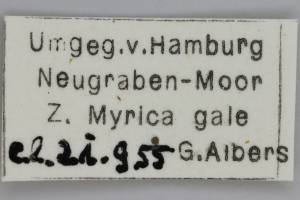

 +23Kontinente:EU
+23Kontinente:EU







1. Lebendfotos
1.1. Falter
1.2. Ausgewachsene Raupe
1.3. Jüngere Raupenstadien
1.4. Fraßspuren und Befallsbild
1.5. Puppe
2. Diagnose
2.1. Geschlecht nicht bestimmt
2.2. Erstbeschreibung
3. Biologie
3.1. Habitat
3.2. Nahrung der Raupe
- [Salicaceae:] Salix caprea (Sal-Weide)
- [Salicaceae:] Salix cinerea (Grau-Weide)
- [Salicaceae:] Salix aurita (Ohr-Weide)
- [Salicaceae:] Salix viminalis (Korb-Weide)
- [Myricaceae:] Myrica gale (Gagelstrauch)
- [Rosaceae:] Pinus contorta (Küsten-Kiefer)
Die Raupe wird hauptsächlich an Weiden feuchter oder auenartiger Standorte geunden, also an Salix cinerea, Salix aurita oder Salix viminalis, aber auch an Salix caprea und - wie viele Salix-Fresser, auch des öften an Myrica gale.
Völlig aus dem Rahmen fällt die von Hancock et al. (2015) mitgeteile Angabe von Winter (1974), die ich zwar noch nicht im Detail studieren konnte, wo aber davon berichtet wurde, dass die Raupen in einer Aufforstung auch Nadeln von Pinus contorta fraßen. Dies ist sicher nur eine extreme Ausnahmeerscheinung.
Autor: Erwin Rennwald)
4. Weitere Informationen
4.1. Andere Kombinationen
- Pyralis caprana Fabricius, 1798 [Originalkombination]
4.2. Synonyme
- Tortrix piceana Haworth, 1811
- Epinotia semifuscana Stephens, 1829
- Tortrix divellana Hübner, [1832-1833]
- Epinotia semifuscana Stephens, 1834
- Paedisca melaleucana Duponchel in Godart, 1835
- Poecilochroma vittana Westwood & Humphreys, 1845
- Epinotia sciurana (Herrich-Schäffer, 1852)
- Epinotia brunneofasciana (Sheldon, 1935)
- Epinotia fuscana (Sheldon, 1935)
- Epinotia fuscofasciana (Sheldon, 1935)
- Epinotia fuscomaculana (Sheldon, 1935)
- Epinotia griseana (Sheldon, 1935)
4.3. Faunistik
Nach SwissLepTeam (2010) ist die Art auch Faunenbestandteil der Schweiz (Jura, Schweizer Mittelland).
Beshkov & Langourov (2004: 551) melden die Art mit Vorbehalt neu für Bulgarien: “Djebelska Reka river below Tarnovtsi Village, Djebel district, 380m alt., 21.10.2003, S. Beshkov, P. Beron & B. Petrov leg. 1 ♀, genitalia checked, but misidentification is possible; the specimen differs from other specimens from this species from Europe. This species is not included for Bulgarian fauna in KARSHOLT & RAZOWSKI (1996: 147), therefore if it is correctly identified, it seems to be a new species for Bulgaria.”
4.4. Literatur
- Beshkov, S. & M. Langourov (2004): Butterflies and Moths (Insecta: Lepidoptera) of the Bulgarian part of Eastern Rhodopes. — In: Beron, P. & A. Popov (eds.) (2004): Biodiversity of Bulgaria. 2. Biodiversity of Eastern Rhodopes (Bulgaria and Greece): 525-676.
- Erstbeschreibung: Fabricius, J. C. (1798): Supplementum Entomologiae Systematicae. I-IV, 1-572. — Digitalisat der Bibliothèque nationale de France: [475].
- [SCHÜTZE (1931): 52]
- SwissLepTeam (2010). Die Schmetterlinge (Lepidoptera) der Schweiz: Eine kommentierte, systematisch-faunistische Liste. — Fauna Helvetica 25. Neuchâtel (CSCF & SEG).
- Winter, T.G. (1974): New host plant records of Lepidoptera associated with conifer afforestation in Britain. — Entomologist's Gazette, 25: 247-258. [Sekundärzitat]





























































